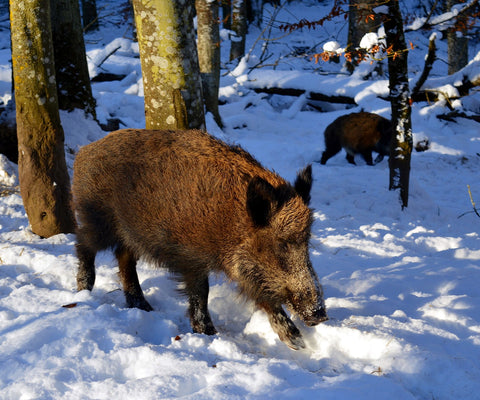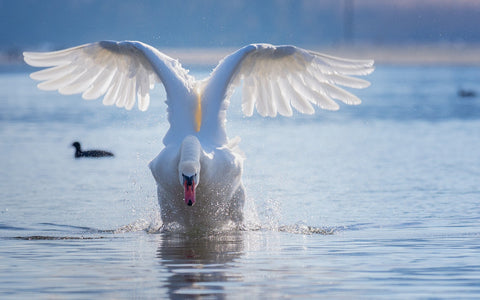Invasive Species Profile: Feral Swine, Mute Swan, Zebra Mussel
- Blog
- 29 Feb, 2024

Happy Invasive Species Awareness Week! In just about every ecosystem in North America, from the bottom of the Great Lakes to the innermost part of the Everglades, the ecology and native plant and animal communities have been affected by invasive species in one way or another. Invasive species are often introduced from other areas of the world where they did not evolve with the natural checks and balances of a native ecosystem, which allows them to take over and thrive, outcompeting native species for resources.
In other cases, invasive species take advantage of anthropogenic sources of food and cover in order to thrive. The effects of invasive species can be detrimental to an ecosystem, and they can be difficult to eliminate. Natural resource managers and conservation agencies put a substantial amount of time and resources into reducing the effects of invasive species. Restoring native ecosystems is good for nutrient retention, preserving food resources for native species, and protecting against disease. With this year’s invasive species awareness week, here are a few noteworthy invaders:

Feral Swine
Feral swine are one of the most well-known invasive species in the hunting world. The first wild pigs were brought to North America by Spanish explorers as a food source in the Southeast. Feral swine are now found throughout North America, including Canada. There have been multiple introductions of this species, including the Eurasian Boar introduced for hunting purposes. Escaped domestic pigs can also quickly become acclimated to the natural environment within only a few generations.
Feral swine are a species of concern because as a large mammal, they can outcompete native species for resources as well as have a large impact on agriculture and landscaping. Pigs naturally forage for food through rooting behavior, which leads to erosion, crop damage and large areas of damaged soil that can damage farm machinery. Their impacts to wetlands are especially severe, rooting the soft soil of riparian areas and impacting sensitive wetland species, as well as degrading water quality through erosion.
Feral swine also have a high reproductive rate and can produce multiple large litters in a year. In addition to their impacts on agriculture and ecosystems, feral swine can also do large amounts of damage to landscaping and can be a safety threat to humans. This adaptable and intelligent species is one of the most impactful invasive mammals in North America.

Mute Swan
Swans! Beautiful, elegant, and… highly aggressive and competitive toward native species?! North America has two species of native swans: the trumpeter swan and the tundra swan. Mute swans were initially introduced as an ornamental species in the Northeast. However, the population grew substantially and their range expanded westward and into the Great Lakes region. Mute swans are known for being extremely territorial and aggressive during the breeding season, even toward humans. They outcompete species of concern such as terns for nesting habitat, and can be dangerous to human safety.
In addition to their aggressive behavior, mute swans eat a large amount of vegetation to outcompete native waterfowl for food. This large bird, which can weigh 25 pounds and have an 8-foot wingspan, can eat 4 to 8 pounds of aquatic vegetation each day. A group of mute swans can denude wetlands of aquatic vegetation, which is an essential food source for other waterfowl species.

Zebra Mussel
Probably one of the more famous aquatic invasive species, the zebra mussel has an outsized impact for a small animal. Zebra mussels are native to European freshwater lakes in Russia and Ukraine, and their larvae are tiny organisms that exist in the water column as they develop. Zebra mussels were first introduced to the Great Lakes when a ship from Europe emptied its ballast tanks, which likely contained zebra mussel larvae in the water, into the Great Lakes.
Zebra mussels colonize any stationary structure in the water, including ships, docks, other species of native mussels, and even the insides of pipes and other industrial equipment. They latch onto these structures with proteins and become extremely difficult to remove, damaging these structures and overwhelming native clams. In addition to their takeover of structures, zebra mussels are extremely efficient at feeding on algae in the water– moreso than native mussels. Native mussel populations are reduced by 90% within 10 years of zebra mussel colonization. This causes an ecosystem imbalance as important food resources are diminished from the food chain.
Additionally, their highly efficient feeding habits cause an increase in water clarity. While this might sound nice, increased water clarity has important ecological repercussions. Sunlight is able to penetrate further down into the water column, reducing habitat for cold-water fish such as lake trout. Entire Great Lakes ecosystems are affected by this invasive mussel.
Foundry Outdoors is your trusted home for buying archery, camping, fishing, hunting, shooting sports, and outdoor gear online.
We offer cheap ammo and bulk ammo deals on the most popular ammo calibers. We have a variety of deals on Rifle Ammo, Handgun Ammo, Shotgun Ammo & Rimfire Ammo, as well as ammo for target practice, plinking, hunting, or shooting competitions. Our website lists special deals on 9mm Ammo, 10mm Ammo, 45-70 Ammo, 6.5 Creedmoor ammo, 300 Blackout Ammo, 10mm Ammo, 5.56 Ammo, Underwood Ammo, Buffalo Bore Ammo and more special deals on bulk ammo.
We offer a 100% Authenticity Guarantee on all products sold on our website. Please email us if you have questions about any of our product listings.



